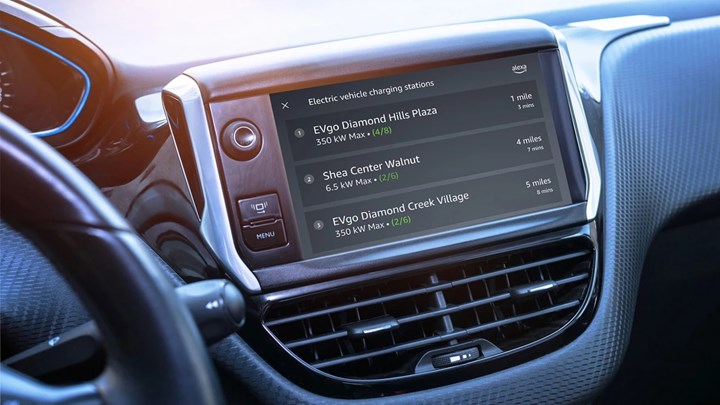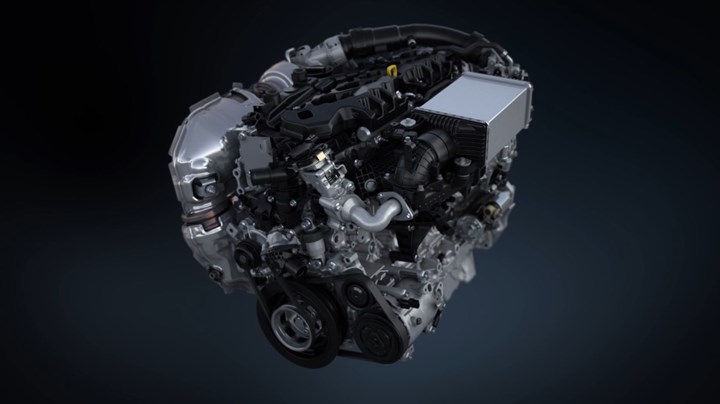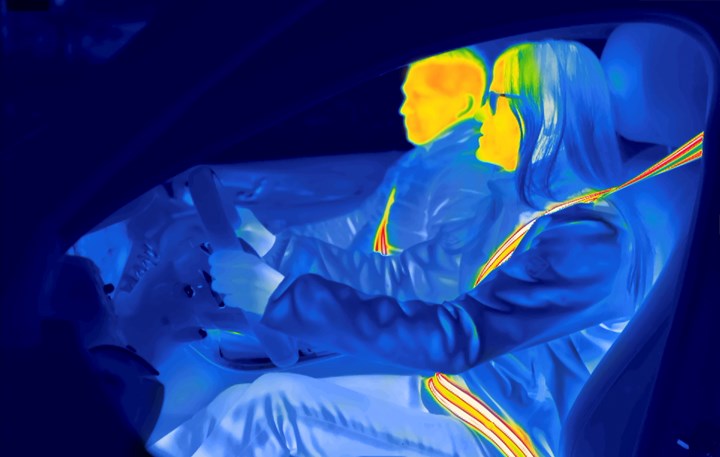on Domestic EV Supply Chains, NACTOY, Facilitating Charging, Powertrains People Prefer, & a Look at Affordability
On EV, DS & U.S.. . . NACTOY Winners. . .Audi in Dakar. . .finding chargers. . .powertrain popularity today and tomorrow. . .VW sales and potential market implications. . .ZF heats up the seat belt. . .Elantra review
EV Production Issue: Geopolitical

Producing e-motors at the Emotors plant operated by the Nidec Leroy-Somer Holding-Stellantis joint venture in Trémery, Lorraine, France. (Image: Stellantis)
While the tax breaks that the Inflation Reduction Act provides purchasers of electric vehicles in the U.S. (clean vehicle tax credit up to $7,500 for cars with an MSRP of not more than $55,000 and utes, vans and pickups costing not more than $80,000) undoubtedly makes them happy (free money!), some of the particulars of the eligibility are making some OEMs unhappy.
For example, the vehicle must have final assembly in North America.
And there will guidance in March from the U.S. Treasury Department on the requirements for the minerals that go into the battery (e.g., minimum percent value for critical materials of 40% in ’23, 50% in ’24. . .) and for the battery components (minimum percent value of 50% in ’23, 60% in ’24 and ’25. . .).
That determination was to have been already wired in, but there were some concerns from OEMs the world over, such as in Europe, where earlier this week the European Commission opened talks with the U.S. on the EV subsidies.
(For obvious reasons the EU-based OEMs are not thrilled about the cost advantage that North American-built EVs have. Ditto for the Japanese and South Koreans.)
Over There
Which leads to something rather amusing in the announcement of the New DS 3 E-TENSE from Stellantis.
The headline:
An Electric Motor Manufactured in France and a Battery Assembled in France
- The 115-kW motor is built in Trémery, Grand-Est
- The 54 kWh battery in Poissy
- The reduction gear in Valenciennes
Assembly of the New DS 3 is performed in Poissy.
Last month, when announcing the ramp up of motor production in the Trémery plant, Stellantis CEO Carlos Tavares said:
“Controlling our electrification value chain will ensure our technological independence in the context of economic and geopolitical crises while mitigating the impact of this dramatic change for our sites and employees, particularly in France where we are and will undoubtedly remain the commercial and industrial leader.”
That motor manufacturing site was once one of the largest diesel manufacturing sites in the world.
Seems that EV nationalism is a real phenomenon.
(To be fair, it should be noted that Stellantis, a global OEM, is investing some $35-billion in electrification by 2025, and a non-trivial amount of that spend is occurring in North America, where it is also building out an EV value chain. Everyone, everywhere, wants one.)
///
NACTOY Names Winners for ‘23

The 2023 North American Car, Truck and Utility of the Year (NACTOY) awards were announced yesterday at the M1 Concourse in Pontiac, Michigan* and the results are:
- Car: Acura Integra
- Truck: Ford F-150 Lightning
- Utility: Kia EV6
And if you want to know a little something more about each of them, you can find the Integra in here, the Lightning here and the EV6 here.
Consider: two out of three are EVs.
*The M1 Concourse is on 87-acres of land that was once covered with vehicle manufacturing facilities. In 1905 there was the Rapid Motor Vehicle Company plant, which built commercial and municipal vehicles. In 1908 General Motors Truck Company came into existence by the consolidation of Rapid, Reliance Motor Truck and Crescent Motors. In 1925 GM acquired a controlling interest in Yellow Truck & Coach Manufacturing, which was rolled onto the site. End of the line was in 2008, when the final plant of the complex that had become known as “Pontiac West” was demolished.
///
Audi Halfway Through Dakar

Another day at the office for Team Audi running the Dakar Rally in a hybrid. (Image: Audi)
The Team Audi Sport campaign at the 2023 Dakar Rally was previously noted because of the clever hybrid powertrain being used in the Audi RS Q e-tron. So since we looked at it once, you may be curious as to how things are going.
After the first half of the race Audi reported on its progress, and because Dakar is unlike races with which you are probably familiar, here’s what the team has encountered as the three cars go racing across Saudi Arabia, and we just don’t mean the sand, camel grass and, yes, a flooded bivouac.
- On the sixth stage, one of the cars had a particularly hard crash on a dune. The co-driver had back pain so he was helicoptered to a hospital. He was diagnosed with a vertebral injury. The team then transported him to Germany for care. He is expected to recover without permanent injury. The driver, Stéphane Peterhansel, said, “I have no more memories of the accident, so hard was the landing.”
- Another of the Team Audi cars had its left front wheel torn off—landing in the same spot.
- And the third car, had “anomalies in the electrical system, including a malfunction of a sensor.” A precautionary measure of changing the high-voltage battery was made. Then on the next stage of the race the car hit a stone that broke the rear left suspension, and the following day damage to the cooling system was identified.
Rolf Michl, Head of Motorsport at Audi, exhibits the chin-up attitude of racing teams everywhere:
“This is obviously not the race we had hoped for. However, with nine top-3 stage results over more than 3,000 stage kilometers, we showed that the Audi RS Q e-tron with its low emission powertrain is absolutely competitive. Our goal therefor continues to be first-class stage results.”
When he made that statement there were 1,300 km to go, part of which is through the Empty Quarter.
Seems like the hybrid is holding up its end, however.
///
EV in the U.K.
The longest road in the U.K., the A1, runs from central London to central Edinburgh (and vice versa): 396 miles.
The longest road in the U.S., U.S. 20, runs from Boston to Newport, Oregon (and vice versa): 3,365 miles.
So keep that difference in mind as you consider this result from a survey conducted by Zap-Map, a U.K. electric vehicle charge point mapping service.
It found that of the owners of an EV, 25% also have a fossil fuel-powered vehicle.
As for the vehicle these dual-vehicle owners typically take:
- 85% of daily trips (e.g, shopping, school drop-off) are in the EV
- 71% use the EV for commuting
- 67% take the EV for trips of over 100 miles
- 55% opt for the EV for holidays “likely to involve long cross-country journeys”
“It’s an endorsement for EVs that even when the option is open to take the fossil fuel car, drivers are very happy to stick with electric,” said Melanie Shufflebotham, COO and co-founder of Zap-Map.
While a complete run on the A1 could be accomplished with a stop for one charge, that’s hardly the case for the U.S. 20.
///
Talking and Knowing Charging

Let Alexa find the charging station then take care of the necessary arrangements. (Image: Amazon)
Speaking of charging. . .
“Alexa, find an EV charging station near me.”
Amazon announced that later this year drivers with Alexa enabled in their EVs will be able to say that and be directed to the nearest charging station that is part of the PlugShare network.
And if that happens to be an EVgo charging station (which happens to own PlugShare),
What’s more, the charging can be initiated and paid for through voice activation with Alexa.
Also. . .
While the navi screens of EVs show locations of charging stations, the information is quite limited. (E.g., I’ve been directed to chargers that were in the parking area of a private business—that was fenced off from non-employees. Not particularly useful.)
Another issue is that while the charger might be accurately located, it could be in use.
HERE Technologies—which is probably best known for its mapping for navi systems—has developed a service that not only locates charge points but predicts the likelihood of it being available at a point in the future.
Big Data
The HERE EV Charge Points service aggregates data from some 90% of the public charging operators then applies a machine learning algorithm that employs a variety of factors, such as the time of day, weather and traffic pattern data, to make the determination.
(HERE has lots of data: there are 34 million connected vehicles that provide information for its ADAS and other services. All in, there are some 170 million vehicles globally running HERE services.)
This is not an aftermarket system but something an OEM integrates into its vehicles’ systems.
According to a HERE spokesman, “It does not require the use of the HERE Platform, but certainly can be integrated into that, as well.”
Of course.
///
Powertrain Popularity circa 2033
A few data points from consulting firm Morning Consult that are worth keeping in the back of your mind. These are results from surveys conducted December 29 among some 2,200 Americans.
- 23% are “very likely” to buy or lease an EV in the next 10 years
- 24% are “somewhat likely” to buy or lease an EV in the next 10 years
- 40% are “very likely” to buy or lease a gasoline-powered vehicle in the next 10 years
- 27% are “somewhat likely” to go gas
And here’s a set of numbers that provides some validation for the Toyota approach:
- 25% are “very likely” to get a hybrid in the next 10 years
- 32% are “somewhat likely” to do the same
So in 2033 there’s some likelihood that
- 47% will have an EV
- 57% will have a hybrid
Although that’s 104%, directionally it indicates that hybrids are still going to play a significant role in transportation.
///
Popular Powertrains in the U.K. in ‘22

Mazda e-Skyactiv D six-cylinder diesel engine for the CX-60 in the U.K. You might want to bookmark this for future reference when you want to show someone what a diesel engine looks like. (Image: Mazda)
And while on the subject of powertrain choices. . .
Over in the U.K., overall new vehicle sales for 2022 were down 2%, to 1,614,063 (which makes it Europe’s second biggest market).
Looked at what was under the hoods in terms of market share in ‘22:
- Gasoline (a.k.a., “petrol”): 42.3%
- Battery electric: 16.6%
- Mild hybrid gasoline: 13.6%
- Hybrid: 11.6%
- Plug-in hybrid: 6.3%
- Diesel: 5.1%
- Mild hybrid diesel: 4.5%
Compared to 2021, EVs came on strong, showing a sales increase of 40.1% (267,203 in ’22, 190,727 in ’21), by far the biggest increase of any category (hybrids were second, with a 27.6% increase, though its sales numbers were lower, at 187,948 and 147,246).
Diesels? An annual decline of 38.9%, with mild hybrid diesels having the second-largest decline, 26.7%.
One thing is clear: compression ignition has had its day.
///
VW Numbers Tell a Story

VW Taos: the small CUV that is growing in market popularity. (Image: VW)
Looking back at 2022 U.S. sales numbers, where most OEMs delivered red ink, Volkswagen of America’s results are telling. (And not because it was down 19.7% compared with 2021.)
The company has been increasing its attention to SUVs over the past few years. Although it was something that made its way into the U.S. market with the Beetle, Rabbit, Jetta, and Golf, execs realized that there was a growing interest in things that weren’t cars. The Tiguan was its offering in the compact segment, a segment with vehicles like the Toyota RAV4 and the Honda CR-V. The Tiguan was not particularly competitive, so VW designers and engineers went to work on that.
But one is not enough, so the company launched the Atlas midsize, which was comparatively quickly followed by a variant, the Atlas Cross Sport.
In 2021 it brought in another SUV, the Taos.
And when it launched its electric vehicle in the U.S. 2021, it didn’t go with the ID.3 sedan, as in Europe, but the ID.4, which is ostensibly an SUV.
So let’s look at the SUV sales—which account for 83% of VW’s U.S. sales in 2022—and the comparison with performance of the vehicles in 2021 (the percentage number), which accounted for 83% of VW’s U.S. sales in 2022:
- Atlas: 53,545 -26%
- Atlas Cross Sport: 28,489 -34.2%
- Taos: 59,103 +88.6%
- Tiguan LWB: 88,577 -19.3%
- ID.4: 20,511 +22.5%
VW execs are chuffed with the ID.4 number. After all, the company has announced it wants 55% of all of its sales to be EVs by 2030, and the 2022 numbers have it at 6.8%.
But what is more notable is to look at the vehicles and their base MSRPs:
- Atlas: $35,150
- Atlas Cross Sport: $35,150
- Taos: $24,155
- Tiguan LWB: $26,950
- ID.4: $38,995
Given the huge rise in the Taos numbers, it could be argued (and I would argue the case) that people are looking for affordability. To be sure, people are not opposed to technical amenities, but if the choice is something they can actually buy, seems like this is the direction they’re heading.
What’s more: the sales of the two SUVs under $30K—the Taos and the Tiguan LWB—represent 59% of all the VW SUV sales.
The Point
This isn’t just about VW. Rather, to make the point that as average transaction prices people are paying for vehicles are slightly less than $50K—and realize, according to the latest numbers from the U.S. Census Bureau, the median family income is $70,784—it is going to get to the point where the number of people can take that hit is going to tail off.
Companies that can make vehicles that are more affordable and make money while doing so (not as high margins as they can on full-size SUVs with Unobtanium Trim packages, but money) may likely be the ones that will succeed going forward in the not-too-distant future.
(Note: Yes, Rolls-Royce announced this week that it had its highest-ever annual sales in 2022, with global sales of 6,021 vehicles—the first time in its 118-year history it sold more than 6,000 cars motor vehicles.)
///
Can a Seat Belt Increase EV Range?

ZF researchers and engineers reckoned that if they used the seat belts to warm the driver and passenger in a cold EV, less energy would be required to make them feel comfortable in the winter weather. (Image: ZF)
There are (at least) two ways to see the expected range in an EV to go down in a jiffy, even if you’re at a stop:
- If there is a drive mode selector (as in Eco, Normal, Sport), as soon as you opt for Sport, the digits decline
- When you turn up or down the temperature. (To be fair, when you use Max AC in an ICE vehicle, your MPGs aren’t what the sticker indicates, but then again, when you drive an ICE vehicle your range is likely 300+ miles (even large SUVs with low MPGs have big gas tanks to provide range) and there is likely to be a gas station right over there.
Because it is winter here in the northern hemisphere ZF’s introduction of a new technology for EVs comes at a propitious time:
A heated seat belt.
Visually, the belt looks like any ordinary seat belt. The heating conductors are woven into the fabric structure. The electrical heating circuits are located so there is no interference with the seat belt mechanisms.
So from a packing point of view: No change.
However, when the electric vehicle starts moving and the belt activated, the belt begins to warm up to a toast 97 to 104°F.
No need to warm all the air in the cabin when there’s the heated belt and heated seats.
However, one thing that seems a little unlikely:
Martina Rausch, who is responsible for new seat belt developments at ZF, said that the heated belt works best “When the passengers take off their thick winter jacket” so “the seat belt lies closer and directly against the body.”
Sure, you might take off your winter coat after you’re warmed up, but until that happens. . .
The benefit of the belt?
ZF calculates that it could reduce the amount of heat needed to heat the interior of the vehicle so there would be a range gain of up to 15%.
///
2023 Hyundai Elantra Limited

‘23 Hyundai Elantra. Just look at the way the body-side metal is formed. People paid attention to the execution of this car. (Image: Hyundai)
When the Hyundai Elantra was named the North American Car of the Year™ award winner for 2021, I was the secretary of the NACTOY board. One of the functions of the secretary is to approve all advertising and marketing materials that a winning company produces that includes the name of the award and/or the organization’s logo.
The reason, primarily, is to assure that the ™ is appropriately used.
Hyundai’s various agencies were very—and I do mean very—active in their promoting the award for their compact sedan.
The other finalists in the category were the Genesis G80 and the Nisan Sentra, so the Elantra’s win wasn’t a walk drive in the park.
I bring up that point about reviewing the materials because I watched so many Elantra ads that it seemed as though if I never saw another Elantra that would be OK.
But then the 2023 Elantra Limited showed up and I must admit that I still find it surprising how advanced the exterior design of the vehicle is.
It was the 2011 Hyundai Sonata that put the automotive world on notice that Hyundai was a brand to be reckoned with when it came to the lengths the company would go to to create vehicles that consumers would select because there was nothing cookie-cutter-consensus about their styling. (It didn’t hurt that the company put in the amenities that are segment-above, either.) The “Fluidic Sculpture” design language of that 2011 model was then ported to the Elantra.
Since then, iterated as it has been, I’ve always thought that the Elantra design was superior to that of its bigger brother because the more limited dimensions resulted in lines that are tighter and tauter.
Real sculpture
If you look at the picture at the top of this carefully, slowly moving your eye from the front fascia and then down along the body side to the spoiler integrated into the decklid you can see sharp arcs, angles and insets that truly provide a sculptural form.
Auto designers often claim their work has sculptural qualities to them. In the case of the Elantra, it truly is sculptural, bringing to mind the work of the late American sculptor Tony Smith, who said in an interview for an exhibit at the Museum of Modern Art in 1968:
“Almost everything in the man-made environment, and even in much of nature, is regulated by the axes of length, breadth, and height. The elements from which many of these pieces are made have more axes, and the forms developed from them move in unexpected ways.”
And that, I submit, is characteristic of what is being achieved with the Elantra exterior design.*
Of course. . .
Of course, because this is a car that people will get because they, well, need a car to drive as opposed to garage and admire, there are the fundamentals that must be mentioned.
So know that the front-wheel drive car is powered by a 2-liter four that produces 147 hp. It is mated to a continuously variable transmission. This version of the Elantra is not going to give you any torque steer problems.
Dimensionally it is 184.1 inches long, 71.9 inches wide, 55.7 inches high, and has a 107.1-inch wheelbase. To at least put it into context with something, the 2023 Honda Civic is almost exactly the same size, with all dimensional differences to the right of the decimal point (i.e., you won’t be able to eyeball the difference.)
And similarly, the Elantra offers 99.4 cubic feet of passenger volume (Civic: 99 cubic feet) and 14.2 cubic feet of cargo volume (Civic: 14.8).
The Limited package provides various tech, from a 10.25-inch touchscreen for infotainment purposes (there is a volume knob for the audio), leather trimmed front seats, and the Hyundai Digital Key (for those using an Android OS device). There are Apple CarPlay and Android Auto, but wired. There are safety tech like forward collision avoidance, blind-spot alert, smart cruise with stop and go, lane following and lane keeping assist, and more.
The MSRP is $26,350. (With optional paint ($400), carpeted mats ($210) and delivery ($1,095) it came to $28,055.)
Fun fact
Hyundai recently sold its 15th million vehicle in the U.S. Of that number, the vehicle making the biggest contribution—23.6%--is the Elantra.
*Lest there is pearl-clutching that I am equating the design of a car to the work of a highly accomplished artist, it is worth noting that among the collection of MoMA are the original smart car, a 1990 Ferrari Formula One car, a 1963 Porsche 911, and a Type One Volkswagen.
RELATED CONTENT
-
GM Develops a New Electrical Platform
GM engineers create a better electrical architecture that can handle the ever-increasing needs of vehicle systems
-
Multiple Choices for Light, High-Performance Chassis
How carbon fiber is utilized is as different as the vehicles on which it is used. From full carbon tubs to partial panels to welded steel tube sandwich structures, the only limitation is imagination.
-
on lots of electric trucks. . .Grand Highlander. . .atomically analyzing additive. . .geometric designs. . .Dodge Hornet. . .
EVs slowdown. . .Ram’s latest in electricity. . .the Grand Highlander is. . .additive at the atomic level. . .advanced—and retro—designs. . .the Dodge Hornet. . .Rimac in reverse. . .


.jpg;width=70;height=70;mode=crop)






